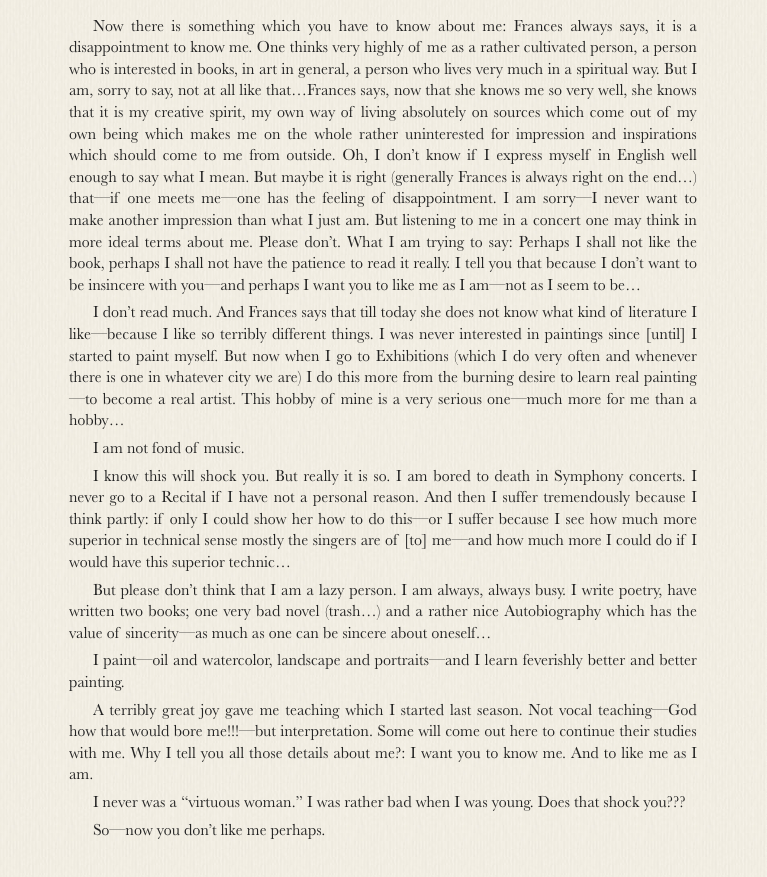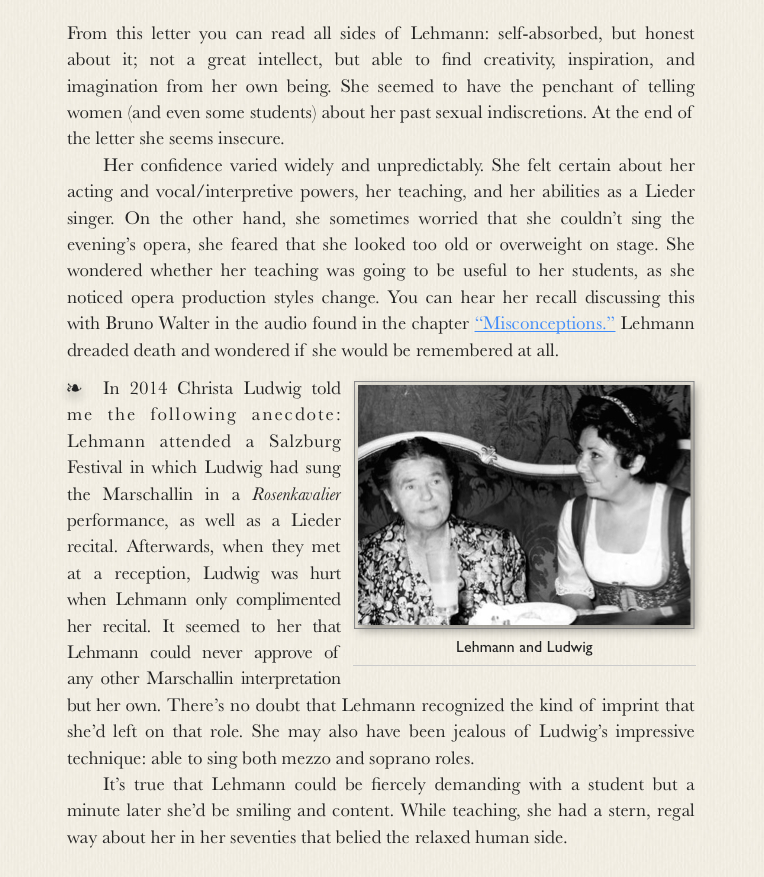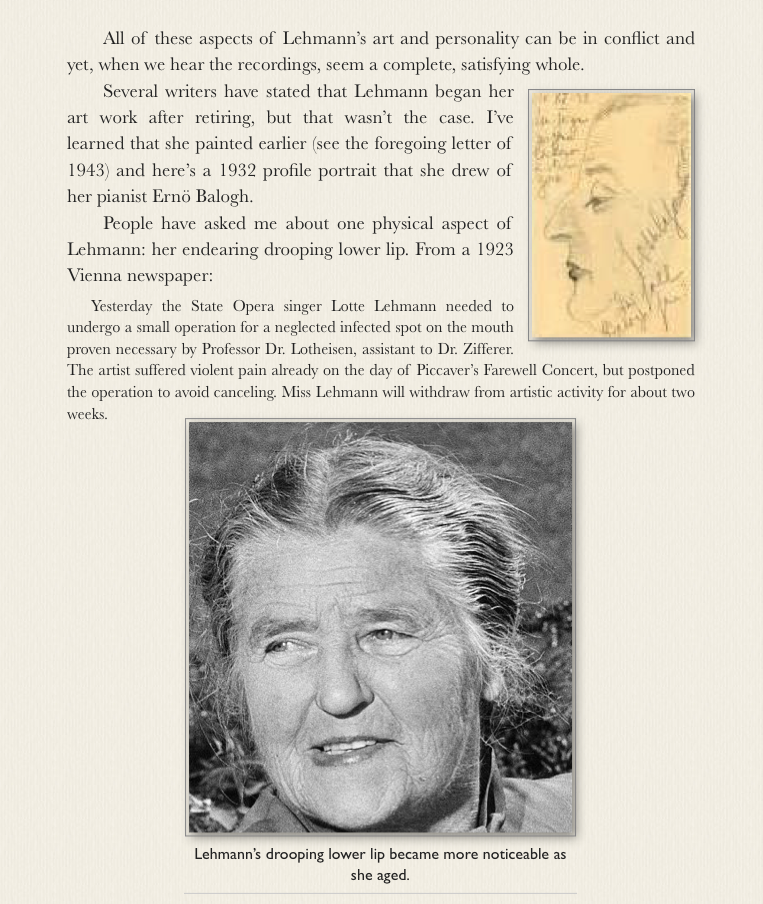Lotte Lehmann & Her Legacy: Volume 2

Lotte Lehmann affected my life in two significant ways. The first was through her supreme artistry and communicative powers, as revealed through her recordings, teaching, and writings. The second was more personal: despite being revered in the world, she became a treasured grandmother figure to me.
Unaware of who she was, I first heard Lehmann when we music majors were assigned “Allerseelen” by Richard Strauss; the only such recording was an old shellac 78rpm (we were already accustomed to LPs). I still remember sitting alone in that listening cubicle enjoying this song. Both the beautiful music and the intense singing came through. Thus I was overwhelmed, when I first met Lehmann, realizing with a shock that she was famous and that I’d heard her already.
In 1961, when I first encountered Lehmann, she had retired from her official teaching duties at the Music Academy of the West. At the time, like many instrumentalists, I held an unspoken prejudice that singers were our inferiors as musicians. So when I drove Katsuumi Niwa, a baritone friend of mine, from UCLA to Santa Barbara for his lessons with “an old German lady,” I expected to be bored. She was courteous to me but during that first lesson I napped on her sofa, in preparation for the long drive back to Los Angeles. But on subsequent visits, as I observed this venerable artist teaching and demonstrating, I felt as if I were entering a new musical world, where words existed on an equal plane with music. Through her profound knowledge and ability to share that with Katsuumi, I found myself gaining a newfound respect for all singers.
How well I remember the impressive house (named Orplid, after the land invented by the poet Mörike in Hugo Wolf’s “Gesang Weylas”) in Hope Ranch Park, a section of Santa Barbara. In particular I enjoyed its wild, untended garden of flowers and trees sloping down toward the ocean. Listening to Katsuumi’s lessons, I felt compelled to acquaint myself with the repertoire he was studying, whether opera arias or, even more significantly for me, Lieder such as Schumann’s cycle Dichterliebe. (See the chapter Dicherterliebe.)
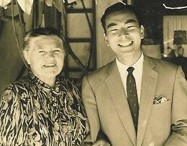
As I followed along in my score, I discovered the depth of Lehmann’s approach to teaching and music-making. No longer did I hear merely a string of notes, at best a display of vocal prowess. Instead, from merely overhearing her tutelage I found a wealth of meaning revealed to me in each word, each phrase. Madame Lehmann (and we did call her that) was the first genius I’d met. Though, as an instrumentalist, I just observed Katsuumi’s lessons, Lehmann always treated me with kindness, including me in conversations that occurred after the lesson.
Inspired by Lehmann’s teaching, I sought out her recordings and read about her. I discovered how she had impressed her audiences in both opera and art song by the directness and spontaneity of her utterance, as well as her instinctive musicality. However, her greatest impact on me as a musician came from observing her in lessons and master classes. Her insights into song literature even had an immediate and lasting effect on me as an instrumentalist. Not only did her ideas of musical phrasing inform my playing, but I always included a Lied or two on my solo double bass recitals.
Even after more than 50 years, here are a few vignettes of Lehmann as teacher that remain in my memory. When Katsuumi studied the role of Pizarro from Beethoven’s Fidelio, I was amazed that Lehmann knew every note, word, and inflection of the role, along with ingenious insights into the character. In Pizarro’s aria “Ha, welch ein Augenblick,” she demanded venom in his delivery. Even more to my surprise, she was equally well versed when teaching the subtleties of Ravel’s Chansons madécasses, which seemed so far from her German world.
When Katsuumi sang “Sonntag” by Brahms with great religious fervor, Lehmann disabused him of the notion that this was a pious song. The Sunday mentioned in the Lied was just the day he saw his girl in front of the church. Lehmann had him sing the words “das tausend schöne Jungfräulein” over and over in order to get him to express their ardor and longing, which, though impossible to translate exactly, she conveyed as “uncountably beautiful girl.” On one occasion, Katsuumi sang “Ungeduld” from Schubert’s Die schöne Müllerin for Martial Singher’s master class at the MAW. Katsuumi and Lehmann had decided that he would sing three of the four verses of the song. Being less than fluent in German, Katsuumi mixed up the words, sampling randomly from various verses, resulting in real goulash. Though most of the audience didn’t know the difference, and Singher made light of it, Lehmann came onstage at the conclusion of the master class and, meeting Katsuumi and me out of view of the audience said—half in anger, half in jest—“You do that again and I keel you!”
The Lehmann connection made me conscious of the beauty and important poetry of the German language. Thus it was obvious for me to study it intensely when in 1973 I arrived in Munich. And Lehmann’s letters, though written to me in English, encouraged my German studies.
One of the great joys for me in attending the Music Academy of the West was its proximity to a breathtakingly beautiful beach. One day, most likely in the summer of 1963, I was swimming at this very beach when I realized with alarm that I was missing Singher’s regularly scheduled art song master class. Brushing the sand off my feet, I ran up the cliffs and directly into the lobby of what is now called Lehmann Hall. The Academy’s stern director stopped me at the entrance: “You can’t go in there without shoes!” Lehmann, seated in the back of the audience and overhearing the exchange, came to my rescue. “Gary,” she said, “come sit with me.” The director could hardly object to the invitation of one of the MAW’s founders, now Honorary President; I took my seat next to Lehmann.
It was in the same class of Singher’s, if memory serves, that a soprano sang the Richard Strauss song “Ständchen.” At the song’s climax on the words “hoch glühn,” she held the high A for twice the notated length. While making his remarks, Singher noted the alteration, and said, “I believe that was all right with the composer. What about that, Mme Lehmann?” She rose and with conviction and pride in her voice said, “Ja, Strauss told me…” at which point laughter and applause rang out in the audience as she stood, beaming.
Whenever I visited Orplid I was conscious of all the art work (not just paintings) which flowed from Lehmann’s creativity. It was another level of her involvement with art that seemed completely in concert with her musical interests. In Volume I you saw her art work for every song of Winterreise and in this presentation you’ll find the same attention to Dichterliebe. Die schöne Müllerin also received her intense artistic effort and those drawings can be found in Volume IV. Lehmann’s work on tiles, mosaics, sculpture, and drawings were everywhere in Orplid to enjoy. The painting below has just recently been discovered.
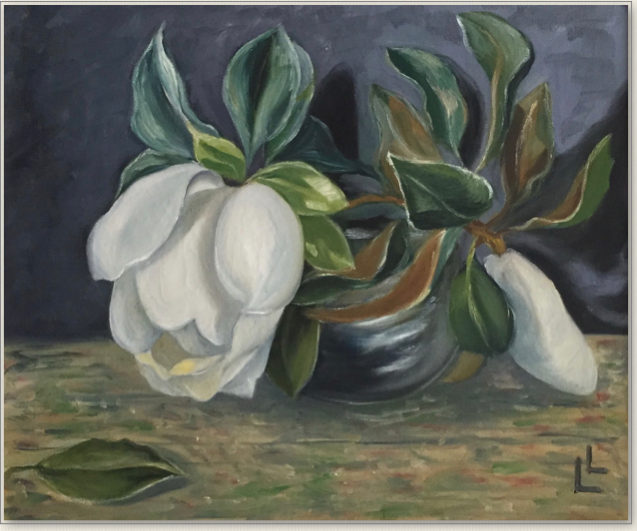
Volume VIII of this series will be devoted exclusively to Lehmann’s art.
Katsuumi and I arrived in New York in the fall of 1963, he studying with Jennie Tourel at Juilliard, and I at the Manhattan School of Music. Lehmann wrote that she was concerned that Katsuumi didn’t have enough warm clothes.
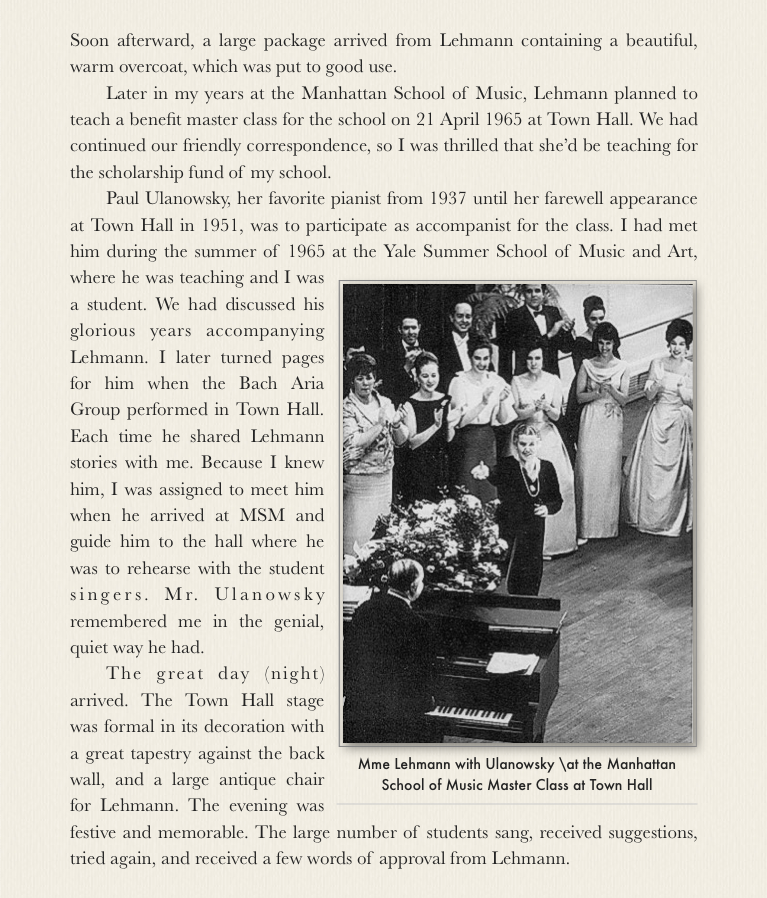

After graduating from the Manhattan School of Music in June 1966, I went to the Philippines for my first full-time professional engagement, playing in the Manila Symphony. Shortly after my arrival, the orchestra’s conductor, Dr. Herbert Zipper, brought me an envelope addressed to me with Lehmann’s flowing signature on the back. Dr. Zipper, who had lived and worked in Vienna, was awestruck that this youngster should receive a letter from the great Lotte Lehmann. “Do you know Madame Lehmann?” he asked. “Oh, yeah, she’s a friend of mine,” I replied casually. “Please give her my best wishes and let her know that I am a great fan,” Dr. Zipper gallantly countered. As Lehmann’s 85th birthday approached, I found myself back in the United States, by this time well acquainted with her recordings and writings. I had the idea of producing a tribute program for WBAI, at that point a classical music public radio station in New York City. Lehmann agreed to a telephone interview and we arranged everything by mail in the fall of 1972. The two-hour special mixed her interview with her opera and Lieder recordings and was a great success. This can be found in Volume 1. Lehmann later agreed to a second interview, which we recorded in August 1973 as a memorial tribute to Lauritz Melchior.
The next month I moved to Germany, where I played as a part-time bassist in an orchestra in Munich. As a young, unknown American, I found myself unable to secure auditions for full-time orchestral posts. Without my asking, Lehmann kindly wrote a letter of recommendation that led to many auditions and an eventual post with the Symphony Orchestra of Berlin.
Lehmann was pleased that I learned German; though I wrote her in that language, she answered in English. In 1974 I sent my impressions upon seeing Strauss’ Frau ohne Schatten in Munich. In response, she replied detailing her insights into the Dyer’s Wife, a role that she had created. In particular she wrote about the difference in the more realistic costume that the Dyer’s Wife wore nowadays. She also remarked that Munich had become the center of great operatic art that Vienna had been in her time. It pleased me to have Lehmann give the stamp of approval to the city I was enjoying so greatly.
Each year on her birthday I sent a gift, no matter where I was at the time. I remember sending her a weird shell with spines that I found in a shop in Manila. At my request Denis Lund calligraphed “An die Musik” as a glorious document fit for hanging on the wall (he sent me a copy that I framed). Lehmann always answered with a nice thank-you note, and we continued to correspond until her death in the summer of 1976. I had noticed her once-flowing handwriting getting squiggly. Upon her death, I received letters from friends from around the world sending condolences, as if her loss was that of a member of my family. It touched me deeply that so many understood what Lehmann had meant to me.
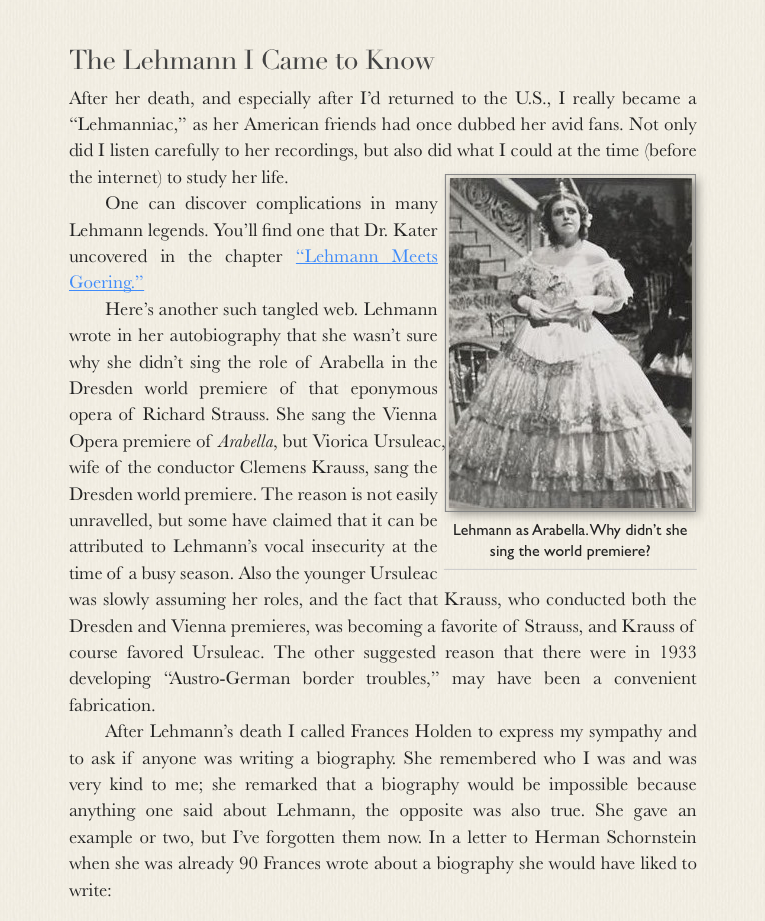
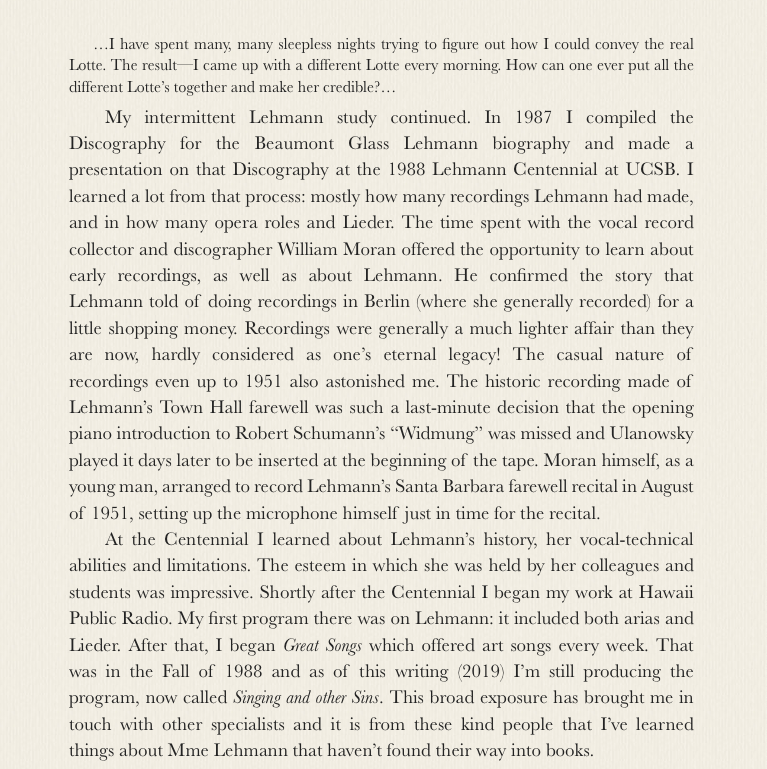
The only Verdi role that Lehmann sang was Desdemona in Otello. She sang it in Vienna, London, Berlin, and Dresden. On these stages critics marveled at her acting and singing. From the last-mentioned city a reviewer wrote: “The glorious voice revels in the high-arched, late-Verdi cantilena, a magnificent, dramatically colored bel canto….” You can hear her excellence of sound and drama in her recording of the Willow Song and the interaction with her maid as she describes her premonition of death. Not recorded is the Ave Maria and prayer. Evidently, as she aged she didn’t feel confident in the high pianissimo A flat at the end of the arpeggio and simply moved her body and hands in such a way as to indicate she was singing the note. No audience member knew.
This same weakness in the high notes plagued Lehmann in the trio in Act III of Der Rosenkavalier. In her final years of singing the role, it was arranged that the clarinet and other woodwinds would “sing” the top B flat. You can hear this in the 1945 excerpt and compare it with the same moments recorded twelve years earlier.
As many singers age, their high range becomes problematic, as does their good intonation. However Lehmann always maintained excellent intonation and the ability to expressively color her voice. One of her expressive devices came to be called the “Lehmann catch breath.” Whether she really needed to breathe or not, this intake of breath certainly heightened the emotion of a particular word or phrase. The Strauss “Ständchen” demonstrates this, but Lehmann also on occasion sang that same phrase without the extra breath. It probably depended on her feeling of the moment. In any case, she also mentioned this expressive breath device in master classes, as you’ll hear in this excerpt from a Boston class.

